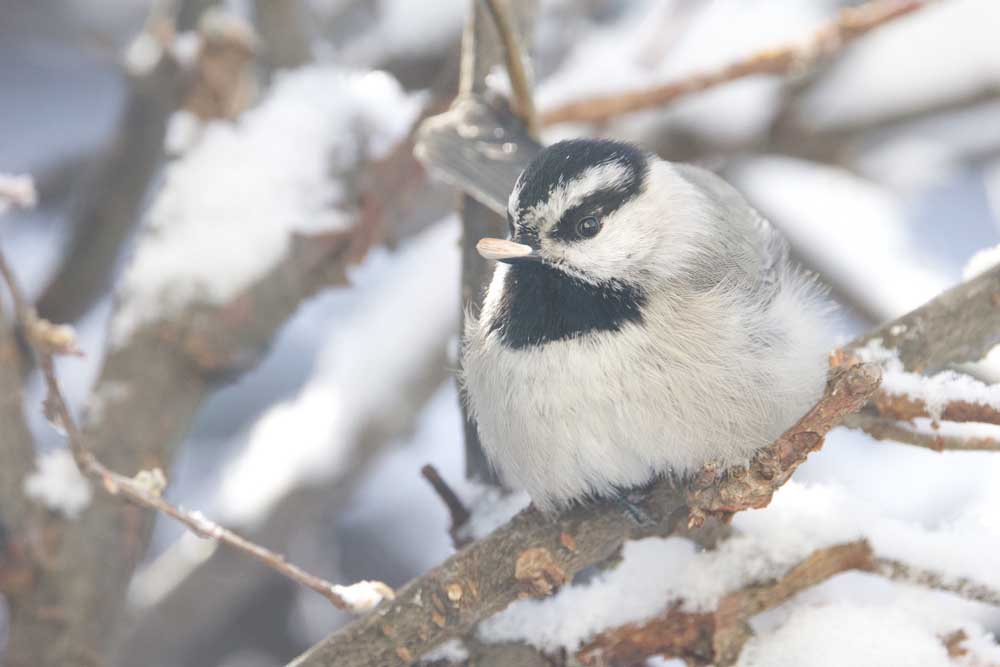Birding: Winter and the birds: Strategies for survival
Published 8:54 am Thursday, February 6, 2025

- We can feed the birds to give them energy and provide them with water and give them places to roost, but their behavior is more important for ultimate winter survival. This mountain chickadee spent the last few days at seed and suet feeders in Calgary during the frigid temperatures.
Weather and birds go together! Weather can affect a bird’s survival. The question is how do the birds adjust to the winter weather that has come to the peninsula and elsewhere in North America?
Lately, because of the wintry weather, there have been many discussions about the strategies that various species use when faced with extremely cold, wintry conditions. Pete Dunne, retired director of the Cape May Bird Observatory, recently released a book on the subject entitled, “The Courage of Birds” (2024). In it, he details “the often surprising ways they survive winter.” The New York Times recently published an article about birds and winter survival (Jan. 31, 2025). I have also read magazine articles recently about the effects of weather such as fire, winter and extreme cold on various species and how they adapt.
In view of the recent snow that arrived on the Long Beach Peninsula, from Feb. 3-4, I think it is a good time to visit what we know about the survival tactics used by birds during winter.
We can feed our feathered friends their favorite seeds and suet! We can also provide clean water for bathing and drinking, but these alone aren’t quite enough to meet a cold winter head on! Their behavior and physicality come into play as well, most of which has evolved over many, many years and generations.
Insulation is a key to warmth for the birds. Thus, beaks are tucked into feathers to keep them warm and conserve heat. Some birds will stand on one leg while pulling up the other into their feathers to conserve heat. Feathers are an important insulator against the cold, a good defense against the cold! David Sibley, the field guide author, calls feathers the most effective insulation known (New York Times, 2025). Behavioral adaptations such as these have resulted in the evolution of particular body parts such that they tend to be smaller in the cold zones of the world compared to their size in warmer zones, where insulation is not as great a necessity.
Another method for conserving heat is roosting together. Science indicates that chickadees, for example, will roost with other chickadees in nest boxes, dense vegetation and holes in trees overnight. Chickadees may also utilize a behavior called torpor. By inducing torpor, the birds lower their body temperature, their heart rate and metabolism. Scientists describe torpor as semi-hibernation. To come out of this state, a bird shakes its body until it resumes normalcy. Another familiar species that can use torpor for cold weather survival is the hummingbird.
Last, but not least, the behavior known as migration is also an effective way that birds deal with winter. Dunne indicates that migration is the “behavior that 70% of North American birds employ in the campaign against winter” (2024). Many of our songbirds leave us in the fall for warmer climes — winter survival at its best.
In summary, we can feed the birds to give them energy and provide them with water and give them places to roost, but their behavior is more important for ultimate winter survival. What avians have learned through the experience of past generations stands them in good stead. Be that as it may, doing our part contributes big time in winter because it also helps our feathered friends to meet winter head on.
Many thanks to the Chinook Observer readers who sent me photos and articles and those who expressed an interest in the issue of bird survival in winter.
Happy birding!









